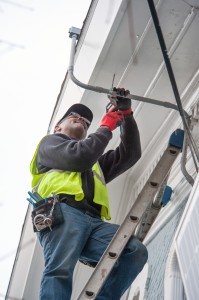Editor’s note: This is the third and final post in a series on transportation funding leading up to the May 5 special election. Read the previous installments here and here.
A lot of what you’ve read about Proposal 1 has probably been about the price Michigan is paying today for our history of inadequately funding our transportation system. Past mistakes—like our flat-rate fuel tax that hasn’t kept pace with inflation—have left us with roads so bad that many local governments are opting to turn them back into gravel, and “structurally deficient” bridges that, in some cases, you can see right through.
It’s all been pretty gloomy. That’s why we wanted to end this series on a hopeful note by offering some glimpses of what Michigan’s transportation future can look like if voters approve Proposal 1. Yes, it will take some time to address the backlog of projects needed to get our infrastructure back in decent shape. But before long, the new funding will support exciting projects that will ultimately add up to the 21st-century transportation system Michigan needs.
Playing catch-up
Roads and bridges are crucial pieces of that system, no doubt. But MEC’s transportation focus is on the environmental, social and economic benefits Michigan will enjoy from improved and expanded passenger rail, public transit and complete streets that address the needs of all users. If Proposal 1 passes, those pillars of our transportation system will see a $116 million annual funding increase.
That sure sounds like a lot, but what does $116 million really get us? Well, to put it in context, the entire startup cost of the planned WALLY commuter rail line from Howell to Ann Arbor is $30 million, plus about $5 million a year to operate the service. The influx of new funding will help get WALLY and similar projects off the ground sooner by providing the matching funds needed to unlock significant federal grants.
Of course, public transportation has a lot of catching up to do in Michigan, since it hasn’t seen a structural funding increase in nearly three decades. Like our roads, public transportation is crumbling in many communities. Some local bus agencies are reducing service and even eliminating routes. So in addition to launching new projects, Proposal 1 would strengthen the foundation of our public transportation network with basic improvements to existing services. A large portion of the new revenue would support local bus operating expenses, which could mean that transit service in your community extends service hours, increases frequency or provides additional route options.
That’s important, because people all over Michigan depend on public transit to accomplish the basic tasks of daily life. It’s how many rural residents get to the grocery store. Seniors and people with disabilities take buses to the doctor’s office or to visit family members. In some urban districts, public buses are the only way for kids to get to school. Without transit, many of our friends and neighbors couldn’t get to the college classes or job interviews that will bring their families new possibilities and stability. The 260,000 rides Michiganders take on public transit every day are essential gateways to opportunity for economic advancement.

Research shows good transit is increasingly important for attracting young talent.
On track to prosperity
The benefits of these investments will extend beyond the day-to-day convenience and access to opportunities they provide for millions of Michiganders, though such benefits are significant. Whether or not we build a modern, complete transportation system will be a deciding factor in Michigan’s economic competitiveness. Report after report tells us that Americans across all age groups are looking for more and better options for getting around. Millennials are getting their licenses and owning cars at ever-decreasing rates. Baby boomers are rethinking the auto-centric lifestyle they grew up with and moving away from car-reliant suburbs. Cultural shifts among these two huge demographic groups demand that we think about our transportation system in a more comprehensive way if we want to attract and retain talent and improve quality of life for everyone.
Read more


















